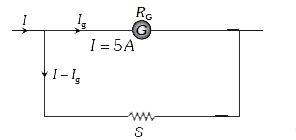A galvanometer having a coil resistance of 60Ω shows full scale defection when a current of 1.0A passes thoguth it. It can vbe convered into an ammeter to read currents up to 5.0A by
Putting in parallel a resistance of 240Ω
Putting in series a resistance of 15Ω
Putting in series a resistance of 240Ω
Putting in parallel a resistance of 15Ω
The correct Answer is:D
RG=60Ω

Ig=1amp,
IgRG=(I−Ig)S
⇒S=IgRGI−Ig=605−1=15Ω
Topper's Solved these Questions
- BOOK - ERRORLESSCHAPTER - CURRENT ELECTRICITYEXERCISE - ASSERTION AND REASON26videos
CURRENT ELECTRICITY
- BOOK - ERRORLESSCHAPTER - CURRENT ELECTRICITYEXERCISE - NCERT BASED QUESTIONS (HEATING EFFECT OF CURRENT)67videos
CURRENT ELECTRICITY
- BOOK - ERRORLESSCHAPTER - ATOMIC AND NUCLEAR PHYSICSEXERCISE - Assertion and Reason23videos
ATOMIC AND NUCLEAR PHYSICS
- BOOK - ERRORLESSCHAPTER - ELECTROMAGNETIC INDUCTIONEXERCISE - ASSERTION & REASON20videos
ELECTROMAGNETIC INDUCTION
Similar Questions
A moving coild galvanometer of resistance 20Omega gives a full scale deflection when a current of 1mA is passed through it. It is to be converted into an ammeter reading 20A. But the resistance of the only shunt available is 0.005Ω. What resistance should be connected in series with the galvanometer coil?
View SolutionA moving coil galvanometer of resistance 20Ω gives a full scale deflection when a current of 1mA is passed through it. It is to be converted into an ammeter reading 20A on full scale. But the shunt of 0.005Ω only is available. What resistance should be connected in series with the galvanometer coil?
View Solution
Knowledge Check
- Question 1 - Select One
A galvanometer having a coil resistance of 60Ω shows full scale defection when a current of 1.0A passes thoguth it. It can vbe convered into an ammeter to read currents up to 5.0A by
Aputting in parallel a resistance of 240ΩBputting in series a resistance of 15ΩCputting in series a resistance of 240ΩDputting in parallel a resistance of 15Ω - Question 2 - Select One
A galvanometer having a coil resistance of 60Ω shows full scale defection when a current of 1.0A passes thoguth it. It can vbe convered into an ammeter to read currents up to 5.0A by
APutting in series a resistance of 15ΩBPutting in series a resistance of 240ΩCPutting in parallel a resistance of 15ΩDPutting in parallel a resistance of 240Ω - Question 3 - Select One or More
A galvanometer with a coil of resistance 50Ω shows full-scale deflection when 10 mA current passes through it.
AThe galvanometer can measure a maximum voltage of 0.5 V.B5 A current can be measured if a shunt of 0.1Ω is connected in parallel to it.CIt can be used as voltmeter to measure a voltage of 5 V if 450Ω resistance is connected in series with the coil of the galvanometer.DIt can be used as a voltmeter to measure a voltage of 50 V if 4,950Ω resistance is connected in series with the coil of the galvanometer.
A galvanometer of resistance 50Ω gives full scale deflection when a current 10−3A is passed through it converted into an ammeter to measure 0.5A current.
View SolutionA galvanometer having a resistance of 75Ω gives the full scale deflection for the current of 25mA. The shunt required to convert it into an ammeter to measure the current up to 59 A is
View SolutionA galvanometer having a coil resistance of 100 Ω gives a full scale deflection, when a current of 1 mA is passed through it. The value of the resistance, which can convert this galvanometer into ammeter giving a full scale deflection for a current of 10 A, is
View SolutionA moving coil galvanometer has a resistance of 9.8Ω and gives a full scale deflection when a current of 10 mA is passed through it. The value of the shunt required to convert it into a milliameter to measure currents upto 500 mA is
View SolutionA galvanometer having a coil resistance of 100ω gives a full scale deflection , when a current of 1mA is passed through it. The value of the resistance, which can convert this galvanometer into ammeter giving a full scale deflection for a current of 10A , is :
View Solution

